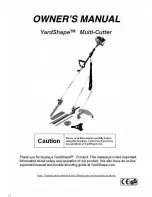
5. Appendix
9
Rev. 2
5.
A
PPENDIX
General Maintenance
To maintain optimum performance and minimize wear, fixtures should be cleaned frequently. Usage and
environment are contributing factors in determining frequency. As a general rule, fixtures should be cleaned at
least twice a month. Dust build up reduces light output performance and can cause overheating. This can lead
to reduced lamp life and increased mechanical wear. Be sure to power off fixture before conducting
maintenance.
•
Unplug fixture from power.
•
Use a vacuum or air compressor and a soft brush to remove dust collected on external
vents.
•
Clean all glass when the fixture is cold with a mild solution of glass cleaner or Isopropyl
Alcohol and a soft lint free cotton cloth or lens tissue.
•
Apply solution to the cloth or tissue and drag dirt and grime to the outside of the lens.
•
Gently polish optical surfaces until they are free of haze and lint.
The cleaning of external optical lenses and/or mirrors must be carried out periodically to optimize light output.
Cleaning frequency depends on the environment in which the fixture operates. Damp, smoky or particularly dirty
surroundings can cause greater accumulation of dirt on the unit’s optics. Clean with soft cloth using normal
glass cleaning fluid. Clean the external optics at least every 20 days. Clean the fixture at least every 30/60
days.
Always dry the parts carefully after cleaning them.
Never spin a fan using compressed air.
Power Linking
You will need a serial data link to run light shows of one or more fixtures using a DMX controller or to run
synchronized shows on two or more fixtures set to a master/slave operating mode. The combined number of
channels required by all the fixtures on a serial data link determines the number of fixtures the data link can
support.
Fixtures on a serial data link must be daisy chained in one single line. To comply with the EIA-485
standard, no more than 32 fixtures should be connected on one data link. Connecting more than 32
fixtures on one serial data link without the use of a DMX optically-isolated splitter may result in
deterioration of the digital DMX signal.
Maximum recommended serial data link distance: 500 m (1640 ft)
Maximum recommended number of fixtures on a serial data link: 32
Setting the Starting Address
This DMX mode enables the use of a universal DMX controller device. Each fixture requires a start address
from 1~512. A fixture requiring one or more channels for control begins to read the data on the channel
indicated by the start address. For example, a fixture that uses six DMX channels and was addressed to start
on DMX channel 100, would read data from channels: 100, 101, 102, 103, 104, and 105. Choose start
addresses so that the channels used do not overlap, and note the start address selected for future reference. If
you are unfamiliar with DMX, download the DMX Primer from www.chauvetlighting.com.






























